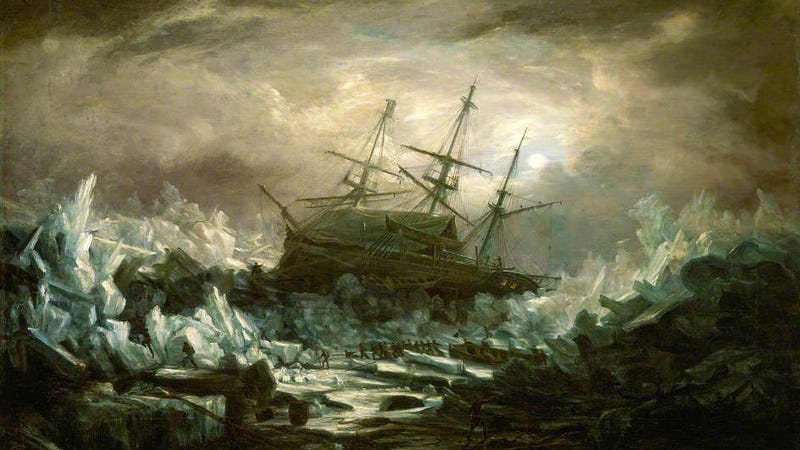One of the great enduring mysteries of exploration is what exactly happened to an expedition through the Northwest Passage led by Sir John Franklin back in 1845. Franklin took two British naval ships – the HMS Terror and Erebus – into the passage in search of the passage into the Pacific Ocean beyond. But none of the 129 men who were with him survived the journey, and exactly what happened to them has remained shrouded in legend and conjecture ever since.
It is widely believed that the two ships became stuck in the ice above Canada while attempting to traverse the Northwest Passage. Those ships were discovered by archaeologists last year, renewing interest in the story and the eventual cause of death of the crew. Obviously chief amongst those causes was likely exposure to the elements, although lead poisoning, scurvy, starvation and tuberculosis have all been speculated as well. Now, one researcher has put forth a possible new explanation.
In a scholarly journal published by the Arctic Institute of North America, University of Michigan dentistry professor Russell Taichman has postulated that a rare conditions called Addison’s disease may have contributed to the death of the crew. The disease is caused by a weakened immune system or from tuberculosis, which autopsies show was afflicting the sailors. The disease makes it difficult for anyone afflicted to maintain weight – even when eating regularly –or stay hydrated, both of which would be deadly in the Arctic.
An examination of the bodies recovered with the ships indicates that many of the crew had lead poisoning and scurvy. The lead poisoning is believed to have come from the canned food that they were eating over a prolonged period of time, as well as lead pipes that were used to create drinking water. The scurvy was due to a lack of fresh fruits and vegetables in their diets. While these were obviously serious concerns for the stranded men, Taichman believes that they only masked the possibility of Addison’s disease running rampant through the crew.
In reality, it was likely a combination of all of these things, and possibly more. The local Inuit tribes still share tales of the crew setting up camps on King William Island, and staying there for some time. That would indicate that the crew survived the sinking of their ships. But what happened next is difficult to say. One thing is certain however, it wasn’t a pleasant place to be, and the death of the crew – no matter how it happened – was probably agonizing.
- Gear Review: The Xero Scrambler Mid is an Ultralight Hiking Shoe for Spring - March 1, 2023
- Gear Review: Yeti Roadie 48 Wheeled Cooler - August 18, 2022
- Kristin Harila Continues Pursuit of 8000-Meter Speed Record - August 16, 2022

Since The explanation in the article is so sparse on info
https://en.wikipedia.org/wiki/Addison%27s_disease
Hence why there was a link in the story tat led to a site with more info.
I have lived with Addison's disease for the last 39 years. Although there is no cure it can be maintained with medication. All of the symptoms that the article describes are what I experienced to a tee for several years until diagnosed.